How To Make Your Dog Laugh (Really!)
Stanley Coren, PhD
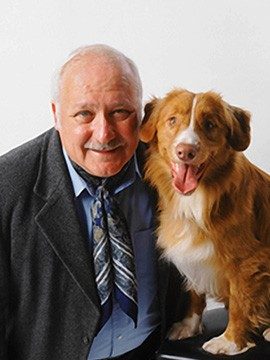 Dogs are capable of laughing, and they typically do so when they are playing. Canine laughter begins with the doggy equivalent of smiling but also includes a sound that is much like panting. Animal behaviorist Patricia Simonet recorded those sounds while dogs played. On analyzing the recordings, she found that they involved a broader range of frequencies than regular dog panting.
Dogs are capable of laughing, and they typically do so when they are playing. Canine laughter begins with the doggy equivalent of smiling but also includes a sound that is much like panting. Animal behaviorist Patricia Simonet recorded those sounds while dogs played. On analyzing the recordings, she found that they involved a broader range of frequencies than regular dog panting.
Do Dogs Smile?
In the minds of most people, the equivalent of a dog smiling is when he is wagging his tail. But there is actually one canine facial expression that comes close to what we mean by smiling in humans. In this expression, slightly opened jaws reveal the dog's tongue lapping out over his front teeth. Frequently the eyes take on a teardrop shape at the same time, as if being pulled upward slightly at the outer corners. It is a casual expression that is usually seen when the dog is relaxed, playing, or interacting socially, especially with people. The moment any anxiety or stress is introduced, the dog's mouth closes and you can no longer see the tongue.
Dogs are also capable of laughing, and they typically do so when they are playing. Canine laughter begins with the doggy equivalent of smiling but also includes a sound that is much like panting. Several years ago, animal behaviorist Patricia Simonet at Sierra Nevada College by Lake Tahoe recorded those sounds while dogs played. On analyzing the recordings, she found that they involved a broader range of frequencies than regular dog panting. In one experiment, Simonet noticed that puppies romped for joy when they heard recordings of these sounds; in another, she was able to show that these same sounds helped to calm dogs in an animal shelter.
How To Make Your Dog Laugh
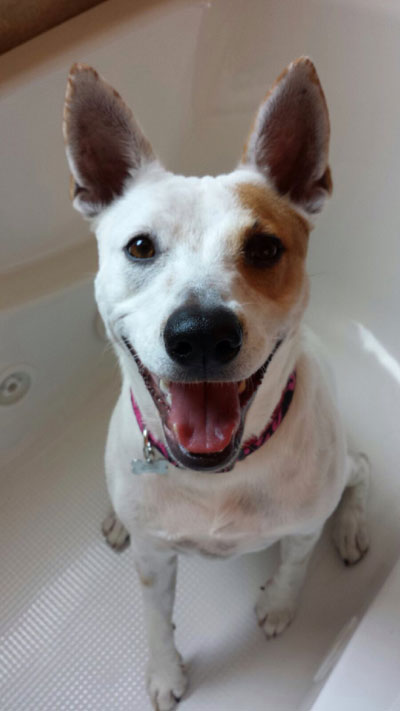 Humans can imitate sounds of dog laughter, but it takes conscious monitoring of mouth shape to get the sound pattern right. Producing dog laughter correctly can make your dog sit up, wag his tail, approach you from across the room, and even laugh along.
Humans can imitate sounds of dog laughter, but it takes conscious monitoring of mouth shape to get the sound pattern right. Producing dog laughter correctly can make your dog sit up, wag his tail, approach you from across the room, and even laugh along.
1. Round your lips slightly to make a "hhuh" sound. Note: The sound has to be breathy with no actual voicing, meaning that if you touch your throat while making this sound, you should not feel any vibration.
2. Use an open-mouthed smiling expression to make a "hhah" sound. Again, breathe the sound; do not voice it.
3. Combine steps one and two to create canine laughter. It should sound like "hhuh-hhah-hhuh-hhah."
Perhaps the most common misinterpretation of dog behavior is based on the myth that a dog wagging his tail is happy and friendly. Although some tail wags are associated with happiness, others can signal fear or even the warning that you are about to be bitten.
The tail's position, specifically the height at which it is held, serves as an emotional meter. If the tail is held at a middle height, the dog is relaxed. As the tail position moves up, it is a sign that the dog is becoming more threatening, with a vertical tail being a clearly dominant signal meaning, "I'm boss around here."
Similarly, barks say a lot about what your dog is thinking. Low-pitched sounds (growls) make the animal seem large and dangerous; they usually indicate anger and the possibility of aggression. High-pitched sounds mean the opposite, a request to be allowed to come closer or a signal from a large dog saying, "It's safe to approach."
Visit Website
Devoting Her Fame To The Animals
Katie Cleary, Peace 4 Animals
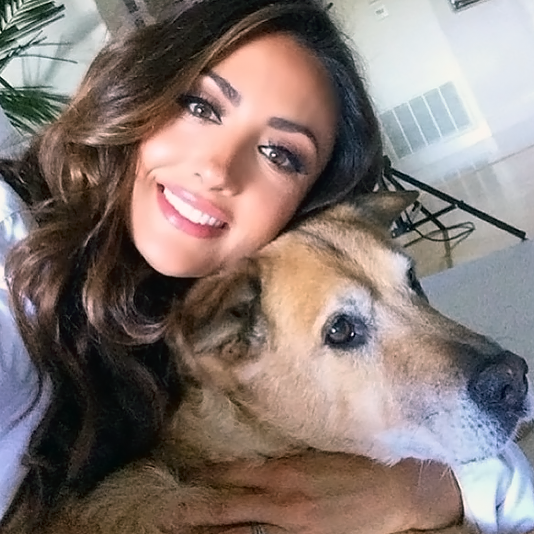 Katie Cleary is a Model, Actress and Philanthropist, Filmmaker who got her start in the entertainment business on the hit TV show America's Next Top Model. After graduating college, Katie landed the role on NBC's hit game show Deal or no Deal. Katie's main passion is advocating animal welfare issues while rescuing and rehabilitating animals and lovingly finding them forever homes. She tells us about her 12 pets.
Katie Cleary is a Model, Actress and Philanthropist, Filmmaker who got her start in the entertainment business on the hit TV show America's Next Top Model. After graduating college, Katie landed the role on NBC's hit game show Deal or no Deal. Katie's main passion is advocating animal welfare issues while rescuing and rehabilitating animals and lovingly finding them forever homes. She tells us about her 12 pets.
Katie currently has nine cats and three dogs. She says that all of her animals are allowed in bed with her at night but her cats are difficult. Her cats are nocturnal, so they keep her up but her dogs are definitely right by her all the time.
When asked if she has ever seen her dogs or cats laugh, she says they laugh at her all the time, plus, they are funny. She says this especially of her first dog Charlie, who just looks at her, tilts his head, and wonders what she is doing.
It's no surprise that Katie spends literally three hours a day cleaning up and taking care of her animals. She says she spends about an hour and a half in the morning and an hour and half at night. She tells us they're not the cleanest animals, but they are worth it.
While Katie currently doesn't have a significant other, it's her friends that tell her 12 animals are a lot. But luckily due to her foundation, Peace 4 Animals, she has help. She has people that come by and watch her cats and walk her dogs.
Ever since an early age, Katie has been into the animals. When she was about 11 or 12 years old, she and her mother would rescue kittens and bottle feed them then find forever homes for them. They also rescued squirrels and birds that would fall from nests. They would rehabilitate them and then rerelease them back into the wild. As a result, Katie grew up essentially rescuing and saving animals. Her family was lucky to have a friend who was a veterinarian, which was really convenient. So any injured animal was taken directly to him. Together, they would all do their part and then release them. She says it was pretty amazing and she always knew she wanted to get involved in animal welfare, she just didn't know to what capacity.
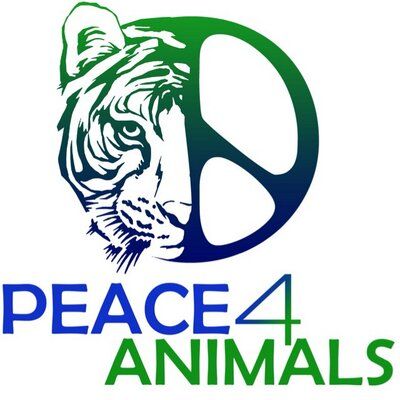 Katie started in the entertainment business at the really young age of 11. In the middle of that, she worked on a campaign for World Wildlife Fund for Tiger Conservation. At that time, there were 5,000 tigers in the wild and now there's only 2,500 tigers left. Rather than being a zoologist or veterinarian, she utilizes entertainment as a platform to raise awareness for animal welfare through legislation, through films, through her news network and works on a lot of issues. She explains that right now we are in the Sixth Mass Extinction. Her passion has always been endangered species and how to prevent extinction of endangered species and big cats as well as elephants and rhinos.
Katie started in the entertainment business at the really young age of 11. In the middle of that, she worked on a campaign for World Wildlife Fund for Tiger Conservation. At that time, there were 5,000 tigers in the wild and now there's only 2,500 tigers left. Rather than being a zoologist or veterinarian, she utilizes entertainment as a platform to raise awareness for animal welfare through legislation, through films, through her news network and works on a lot of issues. She explains that right now we are in the Sixth Mass Extinction. Her passion has always been endangered species and how to prevent extinction of endangered species and big cats as well as elephants and rhinos.
Katie started Peace 4 Animals in 2012 and she's done a myriad of campaigns. She has also rescued farm animals. Her organization rescues dogs from the kill list at shelters because there are so many animals that are so adaptable but a lot of people are afraid to go into shelters to rescue them. Her organization will then pull them and rehabilitate them and find them a good home. They do everything including campaigns and the supporting of legislation. They also produced a film on Netflix called, "Give Me Shelter" about animal welfare. They just finished a second one called, "We Are One," which is a follow up to Give Me Shelter and she's hoping it will be on Netflix.
Along with all of this, Katie is also the Founder & Producer of the network World Animal News on the popular animal news site WorldAnimalNews.com. WAN highlights the latest breaking animal welfare issues happening around the globe with guests ranging from the top animal welfare organizations as well as animal experts and celebrities who are passionate about raising awareness for important animal issues. Some recent articles were on Russia releasing the beluga whales that were held captive and another one about a zoo in Puerto Rico. They highlight animal news worldwide. They have partners around the world that do a lot of support of anti-poaching in Africa, which includes a women's anti-poaching team in Zimbabwe.
Katie's goal is to impact people all around the world with her philanthropic work creating positive change to protect the planet and its precious species, so we can all live in peace together. She hopes to one day open the 'Peace 4 Animals Reserve' to rescue and rehabilitate endangered species in South Africa.
Visit Website
Pheromones In Puppy Training - Dr. Debbie
 So you just got a new puppy and you have all your training tools at the ready, the collar, leash and dog crate. But beyond that, do you have the one thing that can make your training tasks easier all around? Tap into your puppy's own sense of smell using canine pheromones, and ease your new pup's training and transition into the home.
So you just got a new puppy and you have all your training tools at the ready, the collar, leash and dog crate. But beyond that, do you have the one thing that can make your training tasks easier all around? Tap into your puppy's own sense of smell using canine pheromones, and ease your new pup's training and transition into the home.
Pheromones are scent signals emitted by all animal species, including humans. Various pheromones work under the radar to influence the perceptions and behaviors of others within a species.
Shortly after whelping, a pheromone is emitted from the bitch's sebaceous (oil) glands located between the mammary glands. The pheromone, dubbed the canine appeasing pheromone, reassures the puppies, calms them and facilitates nursing. The bitch stops emitting this pheromone as the pups mature, but all dogs retain the ability to "read" this pheromone. Not only do older dogs recognize this pheromone, but it continues to have a natural calming effect on canines of all ages.
In veterinary behavior cases, the dog appeasing pheromone is used for dogs with noise phobias, car travel anxiety, separation anxiety, and other fearful situations. Various forms are available including pheromone collars, plug in diffusers and sprays. The canine appeasing pheromone doesn't sedate the dog; rather it decreases fear and excitability.
The dog appeasing pheromone is also helpful for newly adopted puppies. Those first few days to weeks in a new home are full of changes for the pup faced with novel environments far from the comfort of mother and siblings. The dog appeasing pheromone has been shown to ease the transition of the pup into new home and improve sociability and training during a pup's critical socialization period.
Pheromone Research
For skeptics that need to see the proof in the studies, veterinary behavior studies have examined the positive influence of the dog appeasing pheromone. When comparing treatment responses for dogs with separation anxiety, the use of the dog appeasing pheromone equaled the benefit of the anti-anxiety medication, amitriptyline.
One study looked at 66 puppies as they settled into new homes after adoption. Approximately half of the puppies wore a pheromone collar and half wore a placebo. The study found that puppies wearing a pheromone collar displayed significantly fewer nuisance behaviors like vocalizations or scratching within 3 days of adoption. Pups wearing the pheromone collar woke their owner's less during the night and displayed fewer signs of distress and vocalizations throughout the course of the study.
The researchers concluded that pheromone collars helped both the pup and family. Pups were less stressed and adapted easier. By decreasing the pup's stress and fearful behaviors, the pet owners found a more enjoyable bonding experience with the new pup and faced less frustration through the training process.
 In another study, puppies 8 to 15 weeks were enrolled in an eight-week long puppy socialization and training class. Half wore a pheromone collar and the other half wore a placebo collar. The pups wearing the collar were calmer in the face of novel experiences and displayed less fear, anxiety, and aggression. In the end, the pups with pheromone collar not only were less nervous, but had fewer behavioral problems and learned better. And a long-term effect on sociability was recognized in dogs up to one year after the class and study was completed.
In another study, puppies 8 to 15 weeks were enrolled in an eight-week long puppy socialization and training class. Half wore a pheromone collar and the other half wore a placebo collar. The pups wearing the collar were calmer in the face of novel experiences and displayed less fear, anxiety, and aggression. In the end, the pups with pheromone collar not only were less nervous, but had fewer behavioral problems and learned better. And a long-term effect on sociability was recognized in dogs up to one year after the class and study was completed.
Pheromones and My Pup
As the new owner of a nine-week old Bouvier puppy named Nikki, I used both the pheromone collar and diffuser upon welcoming my new pup home. One day before bringing Nikki home, I placed a pheromone diffuser close to the puppy crate, where it would have maximum benefit during her first nights in the kennel away from mother and siblings. Immediately upon leaving the breeder's home, Nikki was fitted with a pheromone collar to serve as a source of reassuring pheromones that went everywhere she did. The pheromone collar has become a tool in Nikki's socialization. It's on her when she meets new people or animals, when she explores new environments, and during puppy kindergarten class.
Did pheromones help in my pup's transition and training? The four hour drive home from the breeders was a dream, no crying or whining the entire trip. Now three weeks later from acquiring my pup, and Nikki never soiled in her kennel during the day or night. I'll admit I had my share of interrupted sleep in the first two weeks, but most of Nikki's night time wakes were for genuine elimination needs. Overall her transition into the home was smooth and lacked the wailing, inconsolable cries of a stressed pup.
The canine appeasing pheromone isn't a magic bullet though. Nothing matches a quality pup obtained from a reputable breeder who focuses on health, genetics, and early socialization. Likewise pheromones do not replace the hard work and consistent training efforts that any new pet owner must provide. However, by adding the the canine appeasing pheromone to your new puppy training, you can help your pup become the best he or she possibly can.
For more information on the DAP products, visit CEVA.
Featured veterinarian known as "Dr. Debbie" on national pet radio program, Animal Radio. Ebook author of "Yorkshire Terriers: How to Be Your Dog's Best Friend"; "Pugs: How to Be Your Dog's Best Friend"; "Mini Schnauzers: How to Be Your Dog's Best Friend"; and "Shih Tzu: How to Be Your Dog's Best Friend." Dr. Debbie's books.
Visit Website
Animal Radio News - Lori Brooks
 Anti-Vaxxers Don't Want To Vaccinate Pets
Anti-Vaxxers Don't Want To Vaccinate Pets
Just as there are anti-vaxxers who don't want to vaccinate their children because of the fear of autism, there are also people who don't want to vaccinate their pets because of the same reason. However, experts want you know that your pets can't get autism and even if they could, vaccines couldn't cause it. The most common reason people give for not vaccinating their pet (about 20-percent), say pet vaccinations are "not necessary." But, consider this, the most dangerous of all of the dog diseases is rabies, which is effectively a death sentence for a dog. The Humane Society says, "It's incredibly contagious and a pet that gets it has to be euthanized." For some vaccines other than rabies, titer testing may be appropriate to determine if they can be skipped or delayed. Some vets are willing to administer vaccines (other than the rabies vaccine) in small doses, which could be a fifth of a vaccine given weekly over five weeks. But if you have a small dog, don't think that they can receive less of a vaccine. As the experts point out, "It's not a weight-versus-dose question," When you go to the doctor, your small child and you get the same vaccine too.
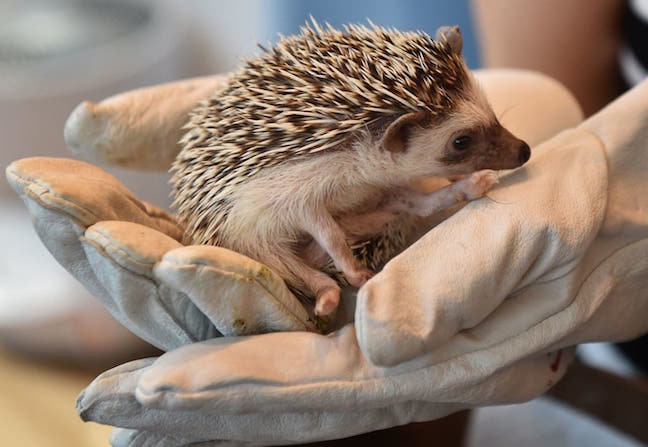 Salmonella Outbreak Linked to Hedgehogs
Salmonella Outbreak Linked to Hedgehogs
The Centers for Disease Control (CDC) has once again issued a warning that recent cases of salmonella have been linked to pet hedgehogs and the agency is warning pet owners to take precautions to avoid infection. A total of 17 people, ranging in age from 2 to 95 across 11 states, have fallen ill with salmonella typhimurium. However, a common supplier of affected hedgehogs has not been identified. The Salmonella bacterium is found in a hedgehog's feces and can often end up on their bodies or in their enclosures. To avoid infection, the CDC recommends that you always wash your hands thoroughly after handling a hedgehog or anything that came from a hedgehog's enclosure; do not snuggle or kiss a hedgehog, as this can bring the germs directly to your face and mouth; don't let hedgehogs roam freely in areas where food is prepared or stored; and clean items from the hedgehog's enclosure outside your house and not in your kitchen.
Government Will No Longer Infect Cats With Diseases
The U.S. Agriculture Department officials say it has stopped a government program that literally infected diseases into cats before they were euthanized. The department's Agricultural Research Service now says the toxoplasmosis experiments on cats and kittens have "been discontinued and will not be reinstated." The protocol involved giving cats toxoplasmosis so scientists could study the food-borne illness. Reliance on cats to study the pathogen has steadily fallen since last May, officials said, and no cat has been exposed since September. Cats are the only hosts in which the T. Gondii parasite can complete its life cycle and produce eggs.
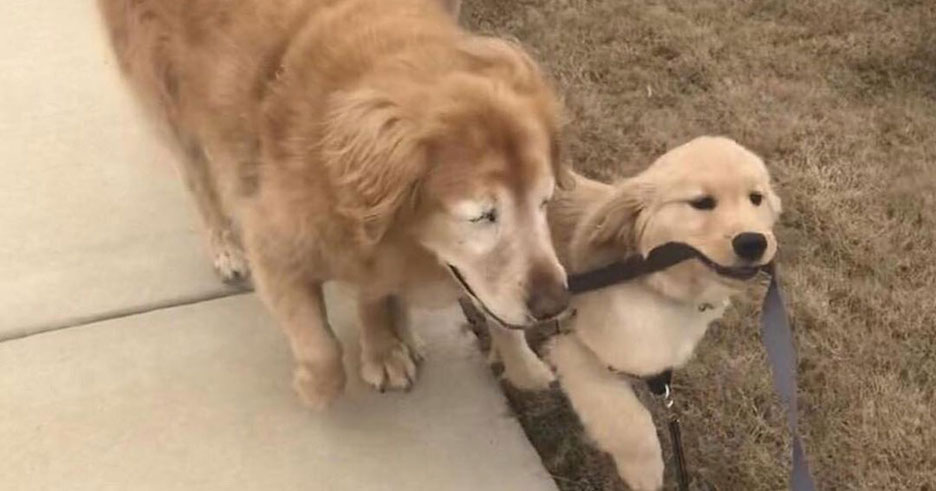 Blind Dog Gets Seeing-Eye Puppy
Blind Dog Gets Seeing-Eye Puppy
A North Carolina couple's puppy is now famous for quickly appointing himself as a seeing-eye-puppy for their 11-year-old golden retriever that lost both of his eyes to glaucoma pain. The puppy, named Maverick, came to their family in January and Charlie, the now blind dog, was at first not excited to have another dog in the house. However, Maverick soon appointed himself as Charlie's protector. "When they would play, Maverick would realize that Charlie had lost the toy, so [Maverick] would pick it up and put it back in front of Charlie to re-engage him in playtime," stated their owner. Yes, they're now famous on social media and have their own Instagram page.
 Listen to the entire Podcast of this show (#1011)
Listen to the entire Podcast of this show (#1011)





